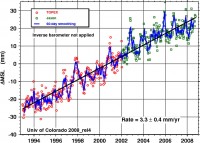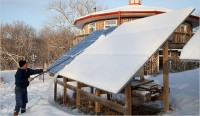By Sean Plambeck, News.AU
Australia’s use of coal and carbon emissions policies are guaranteeing the “destruction of much of the life on the planet”, a leading NASA scientist has written in a letter to Barack Obama. The head of NASA’s Goddard Institute for Space Studies, Professor James Hansen, has written an open letter to Barack Obama calling for a moratorium on coal-fired power stations and the use of next-generation nuclear power.
In the letter he says: “Australia exports coal and sets atmospheric carbon dioxide goals so large as to guarantee destruction of much of the life on the planet.” Prof Hansen said goals and caps on carbon emissions were practically worthless because of the long lifetime of carbon dioxide in the air. “Instead a large part of the total fossil fuels must be left in the ground. In practice, that means coal,” he wrote.
“Nobody realistically expects that the large readily available pools of oil and gas will be left in the ground.” Prof Hansen said that emissions reduction targets, like Kevin Rudd’s goal to cut emissions by a minimum of 5 per cent and up to 15 per cent by 2020, do not work. “This approach is ineffectual and not commensurate with the climate threat,” he wrote of reduction plans.
“It could waste another decade, locking in disastrous consequences for our planet and humanity.”
Professor Hansen also works in the Department of Earth and Environmental Sciences at Columbia University and has given testimony on climate change to the US Congress. He said he wrote to Mr Obama as the incoming US president is in a position to instigate global change and “his presidency may be judged in good part on whether he was able to turn the tide (on climate change) - more important, the futures of young people and other life will depend on that”. He called for the end of coal plants that do not capture and store carbon dioxide and for funding for “fourth generation” nuclear power plants that could run on material now regarded as waste. Comment is being sought from climate change minister Penny Wong.
“Carbon Control Cruasader” Hansen like Gore is criss-crossing the globe advocating immediate, drastic actions to save the planet, even as the temperatures cool and sea levels fall. There is a lot behind the scenes. The New York Times Andy Revkin called out Hansen for exaggerating the threat of sea level rise. And in the Netherlands, former Director Scientific Research of the Netherlands Royal Meteorological Office, Gerbrand Komen took on Hansen and Al Gore who suggested in his movie that his country will be flooded in fifty years, while even if the worst case scenario becomes truth it is expected to take hundreds if not thousands of years. It is this type of misleading information that we as scientists should counterbalance.” This conclusion was also eviden from this paper reported by Roger Pielker Jr. today showing sea level rise has slowed by 20% since 2003.

And scientist Bryan Leyland from nearby New Zealand parses words to interpret his nuclear plans, so aptly commented: “The key word is “next generation”. He is ruling out the current generation of nuclear power stations and wants us to wait another 15 or 20 years for the “next generation”. It is a good way of pretending to support it while, in fact, ruling it out. Nuclear power is a potential solution to the problem that they have invented. They don’t want the solution—because their underlying belief is that economic growth is bad for the environment—so they find weasel ways pretending to support nuclear power, while trying to make sure it doesn’t happen.”
By John McLean
How many times have you heard or read words to the effect that 4000 scientists from the Intergovernmental Panel on Climate change (IPCC) supported the claims about a significant human influence on climate? I think I’ve seen it on television, radio and the Internet and I know that politicians at national levels have quoted such figures. There’s no question whatsoever. It’s utterly wrong.
In fact, once the duplicated names are removed that number falls below 2,900 and if we only want those who explicitly supported the claims it falls to only about 60. So how does 4,000 become 60? Let’s take a closer look at the real numbers.
Consider the statement “The IPCC report concluded that there is a human influence on climate. This was supported by almost 4,000 authors and reviewers.” The popular mythology - and one that IPCC never tries to correct - is that those 4,000 supported the findings but all they really supported, by their work, was the creation of the report. The IPCC is allowing, or perhaps even encouraging, an ambiguity be misinterpreted, and not for the first time either, but I digress.
But how many individuals were involved? Was it 4,000 or some other number? The IPCC said in its flyer for its Fourth Assessment Report (4AR): 2500+ Scientific Expert Reviewers. 800+ Contributing Authors, 450+ Lead Authors. So immediately the figure drops from 4,000 to 3,750 - but a closer check shows that’s not correct either.
John goes on in this analysis to show why the number is closer to 60 and concludes with “We can however be sure that support among those other IPCC authors and reviewers was not unanimous. The lists of reviewers contain the names of many people who are known to be sceptical of a significant human influence on temperature, so any implication that they supported the IPCC’s findings are totally without merit. As mentioned earlier, the support to which the IPCC referred in its flyer was towards the creation of the entire report, not the findings of a small network of climate modellers, although the “sceptical reviewers” would probably argue that their support for the report was only in trying to curb the excesses of the IPCC’s authors.
This document has shown that yet another statement by the IPCC is unsupported by any solid evidence. Not only was the IPCC dishonest about the level of support for its primary claim, either deliberately or through allowing an ambiguity to be misinterpreted, but it couldn’t even get its number of authors and reviewers correct. If the IPCC cannot provide an accurate count of authors, reviewers and the people who acted in both roles for its report then we probably should be asking what, if any, of its statements can be believed.
By Kate Galbraith, New York Times Business
Old Man Winter, it turns out, is no friend of renewable energy. This time of year, wind turbine blades ice up, biodiesel congeals in tanks and solar panels produce less power because there is not as much sun. And perhaps most irritating to the people who own them, the panels become covered with snow, rendering them useless even in bright winter sunshine.
So in regions where homeowners have long rolled their eyes at shoveling driveways, add another cold-weather chore: cleaning off the solar panels. “At least I can get to them with a long pole and a squeegee,” said Alan Stankevitz, a homeowner in southeast Minnesota.

As concern has grown about global warming, many utilities and homeowners have been trying to shrink their emissions of carbon dioxide - their carbon footprints - by installing solar panels, wind turbines and even generators powered by tides or rivers. But for the moment, at least, the planet is still cold enough to deal nasty winter blows to some of this green machinery.
In January 2007, a bus stalled in the middle of the night on Interstate 70 in the Colorado mountains. The culprit was a 20 percent biodiesel blend that congealed in the freezing weather, according to John Jones, the transit director for the bus line, Summit Stage. (Biodiesel is a diesel substitute, typically made from vegetable oil, that is used to displace some fossil fuels.) The passengers got out of that situation intact, but Summit Stage, which serves ski resorts, now avoids biodiesel from November to March, and uses only a 5 percent blend in the summertime, when it can still get cold in the mountains. “We can’t have people sitting on buses freezing to death while we get out there trying to get them restarted,” Mr. Jones said.
Winter may pose even bigger safety hazards in the vicinity of wind turbines. Some observers say the machines can hurl chunks of ice as they rotate.
Read more here.


